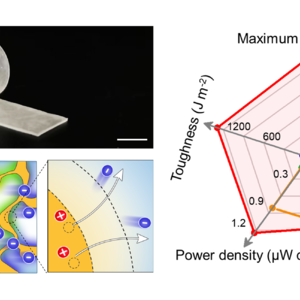Piezoionic Elastomers by Phase And Interface Engineering for High-Performance Energy-Harvesting Ionotronics
Citation
Weiyan Zhu, Baohu Wu, Zhouyue Lei*, and Peiyi Wu*. Piezoionic Elastomers by Phase And Interface Engineering for High-Performance Energy-Harvesting Ionotronics. Adv. Mater. 2024, 36, 2313127.
Abatract
Piezoionic materials play a pivotal role in energy-harvesting ionotronics. However, a persistent challenge lies in balancing the structural requirements for voltage generation, current conduction, and mechanical adaptability. The conventional approach of employing crystalline heterostructures for stress concentration and localized charge separation, while effective for voltage generation, often compromises the stretchability and long-range charge transport found in homogeneous quasi-solid states. Herein, we introduce phase and interface engineering strategy to address this dilemma and present a piezoionic elastomer that seamlessly integrates ionic liquids and ionic plastic crystals, forming a finely tuned microphase-separated structure with an intermediate phase. This approach promotes charge separation via stress concentration among hard phases while leveraging the high ionic charge mobility in soft and intermediate phases. Impressively, the elastomer achieves an extraordinary piezoionic coefficient of about 6.0 mV kPa−1, a more than threefold improvement over current hydrogels and ionogels. The resulting power density of 1.3 μW cm−3 sets a new benchmark, exceeding that of state-of-the-art piezoionic gels. Notably, our elastomer combines outstanding stretchability, remarkable toughness, and rapid self-healing capability, underscoring its potential for real-world applications. This work may represent a stride toward mechanically robust energy harvesting systems and provide insights into ionotronic systems for human-machine interaction.



